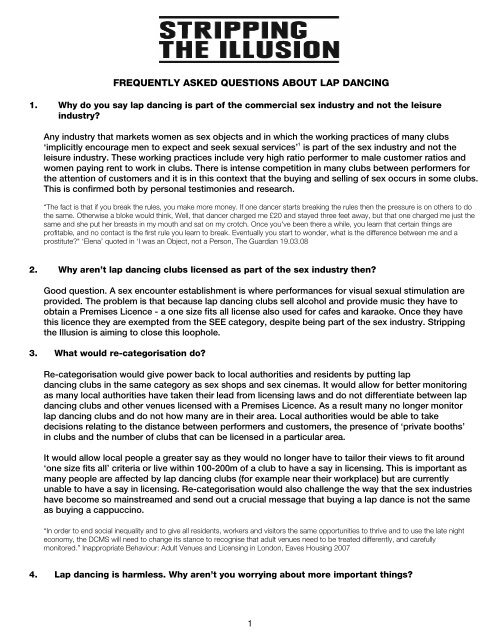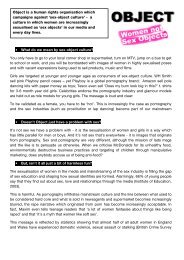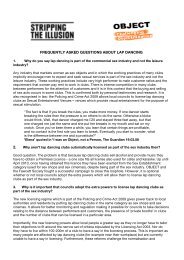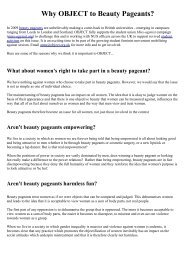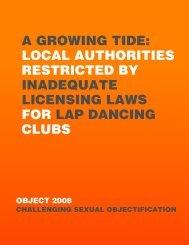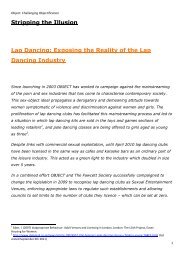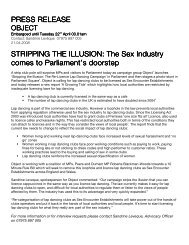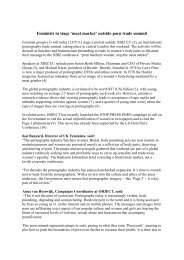FREQUENTLY ASKED QUESTIONS ABOUT LAP DANCING - Object
FREQUENTLY ASKED QUESTIONS ABOUT LAP DANCING - Object
FREQUENTLY ASKED QUESTIONS ABOUT LAP DANCING - Object
Create successful ePaper yourself
Turn your PDF publications into a flip-book with our unique Google optimized e-Paper software.
<strong>FREQUENTLY</strong> <strong>ASKED</strong> <strong>QUESTIONS</strong> <strong>ABOUT</strong> <strong>LAP</strong> <strong>DANCING</strong><br />
1. Why do you say lap dancing is part of the commercial sex industry and not the leisure<br />
industry?<br />
Any industry that markets women as sex objects and in which the working practices of many clubs<br />
‘implicitly encourage men to expect and seek sexual services’ 1 is part of the sex industry and not the<br />
leisure industry. These working practices include very high ratio performer to male customer ratios and<br />
women paying rent to work in clubs. There is intense competition in many clubs between performers for<br />
the attention of customers and it is in this context that the buying and selling of sex occurs in some clubs.<br />
This is confirmed both by personal testimonies and research.<br />
“The fact is that if you break the rules, you make more money. If one dancer starts breaking the rules then the pressure is on others to do<br />
the same. Otherwise a bloke would think, Well, that dancer charged me £20 and stayed three feet away, but that one charged me just the<br />
same and she put her breasts in my mouth and sat on my crotch. Once you've been there a while, you learn that certain things are<br />
profitable, and no contact is the first rule you learn to break. Eventually you start to wonder, what is the difference between me and a<br />
prostitute?" ‘Elena’ quoted in ‘I was an <strong>Object</strong>, not a Person, The Guardian 19.03.08<br />
2. Why aren’t lap dancing clubs licensed as part of the sex industry then?<br />
Good question. A sex encounter establishment is where performances for visual sexual stimulation are<br />
provided. The problem is that because lap dancing clubs sell alcohol and provide music they have to<br />
obtain a Premises Licence - a one size fits all license also used for cafes and karaoke. Once they have<br />
this licence they are exempted from the SEE category, despite being part of the sex industry. Stripping<br />
the Illusion is aiming to close this loophole.<br />
3. What would re-categorisation do?<br />
Re-categorisation would give power back to local authorities and residents by putting lap<br />
dancing clubs in the same category as sex shops and sex cinemas. It would allow for better monitoring<br />
as many local authorities have taken their lead from licensing laws and do not differentiate between lap<br />
dancing clubs and other venues licensed with a Premises Licence. As a result many no longer monitor<br />
lap dancing clubs and do not how many are in their area. Local authorities would be able to take<br />
decisions relating to the distance between performers and customers, the presence of ‘private booths’<br />
in clubs and the number of clubs that can be licensed in a particular area.<br />
It would allow local people a greater say as they would no longer have to tailor their views to fit around<br />
‘one size fits all’ criteria or live within 100-200m of a club to have a say in licensing. This is important as<br />
many people are affected by lap dancing clubs (for example near their workplace) but are currently<br />
unable to have a say in licensing. Re-categorisation would also challenge the way that the sex industries<br />
have become so mainstreamed and send out a crucial message that buying a lap dance is not the same<br />
as buying a cappuccino.<br />
“In order to end social inequality and to give all residents, workers and visitors the same opportunities to thrive and to use the late night<br />
economy, the DCMS will need to change its stance to recognise that adult venues need to be treated differently, and carefully<br />
monitored.” Inappropriate Behaviour: Adult Venues and Licensing in London, Eaves Housing 2007<br />
4. Lap dancing is harmless. Why aren’t you worrying about more important things?<br />
1
Lap dancing clubs encourage their customers, and wider society to see women as sex objects. They<br />
reinforce the idea that women are always sexually available, as long as you’ve got a bit of cash to spare.<br />
This has to be seen in the wider context of a society in which men still dominate the positions of power<br />
and where violence against women is endemic, with 1 in 4 women facing rape in her lifetime and 1 in 2<br />
women facing sexual harassment, stalking or domestic violence. Those working with female victims of<br />
male violence believe that the mainstreaming of the sex industries legitimises the attitudes that<br />
ultimately lead to violence against women.<br />
The fact that we are bombarded with sexist images of women in poses which stem from pornography,<br />
depicting women as always up for sex, no matter what, cannot be disconnected from endemic violence<br />
against women, low conviction rates, and the fact that the majority of people still think that women are<br />
at least partly to blame if they are sexually assaulted (Amnesty International, Sexual Assault Research<br />
2005). For something to be harmless it would need to be proven that it has no effect whatsoever on<br />
these worrying statistics. Can you say with confidence that this is the case?<br />
“The use of women in degrading entertainment exacerbates violence against women…lap dancing and similar clubs be regulated to<br />
ensure that local crimes against women do not increase” Women’s National Commission (WNC) report to the UN Commission on the<br />
Elimination of Discrimination Against Women (CEDAW) 2005<br />
5. But isn’t lap dancing empowering for women?<br />
What kind of power are we talking about? Can sexual power get you equal pay, equal representation<br />
and an equal voice? You also have to look at why lap-dancing is seen as empowering. Why is it that in<br />
our society stripping off and posing to satisfy men is a key way we’re told to empower ourselves? The<br />
porn industry has saturated mainstream culture so much that what is essentially a sexist and<br />
exploitative industry is now seen as ‘normal’ and ‘empowering’. How can an industry which makes huge<br />
profits from manipulating men and sexually objectifying women be empowering?<br />
The power relations inside lap dancing clubs aren’t that simple either. Of course not every experience is<br />
the same, but if women have all the power in lap dancing clubs why do so men admit that it is not just<br />
sexual titillation which keeps them coming to clubs but the power trip that they get from paying a<br />
performer to strip for them?<br />
“Lap dancing is about creating a situation whereby the men feel they are doing you a favour - that's the way the game is set up, so all the<br />
power is with the customer … [she believes that] for men who visit lap dancing clubs, enjoyment derives primarily from handing over the<br />
money, not from the dance itself” ‘Elena’ quoted in ‘I was an <strong>Object</strong>, not a Person, The Guardian 19.03.08<br />
6. Aren’t you being prudish in having a problem with the sex industry and lap dancing?<br />
Just like we don’t accuse anti-McDonalds protestors of being ‘anti-food’, challenging the normalisation<br />
of the sex industry doesn’t mean you have a problem with sex! We don’t have a problem with nudity, we<br />
have a problem with how the mainstreaming of lap dancing clubs reinforces the idea that a woman can<br />
be bought and sold to provide sexual services of some kind.<br />
Recent research into men who buy sex in East London 3 highlighted that men were put off from sexually<br />
exploiting women when they started considering them as people. Viewing women as people and not as<br />
objects is a crucial step in changing attitudes. Challenging lap dancing is not about challenging sexual<br />
expression, it is about pointing out the danger of continuing to represent women as sex objects who are<br />
always gagging for it in a culture in which sexual violence is so common.<br />
“The lack of respect paid to women who sell sex was evident in the negative and derogatory attitude of some of the buyers. Perhaps<br />
most interesting was the suggestion in one interview that viewing women as people was itself a deterrent. This illustrates conclusively that<br />
men can and do change their attitudes towards buying sex and a key avenue to achieve this is through recognition of women’s<br />
subjectivity and the contributions men (even as individuals) can make to reducing gender inequality. Coy, Kelly and Horvath (2007) It’s just<br />
like going to the supermarket: Men buying sex in East London Report for Safe Exit<br />
2
7. Lap dancing clubs are about fantasy, we know the difference between fantasy and<br />
reality so what’s the problem?<br />
When we are bombarded with images and messages from a young age that reinforce and legitimise one<br />
kind of ‘fantasy’ as if it represents the only way to view sex and sexuality, this has an impact on all<br />
sexual relations. When this ‘fantasy’ involves the buying and selling of women as commodities and<br />
reinforces the idea that women can be bought and sold as easily as a cup of coffee this impacts on the<br />
way that women are viewed in society. When we live in a society in which sexual violence against<br />
women is endemic, and women are not represented in positions of power and influence, this ‘fantasy’<br />
becomes more disturbing. The levels of sexual harassment that occur in lap dancing clubs are well<br />
documented – and is evidence that this ‘fantasy’ sometimes hides a darker reality.<br />
“I think every dancer has some kind of story to tell. It’s that kind of environment where guys feel that they can. We’re out there, we’re<br />
vulnerable, and they can. We walk around by the customers and a lot of people would grab our arses, that happens constantly. There’s<br />
rules there, but rules are always being bent. Quoted in Wesley, J.K. (2002) Growing up sexualised: Issues of Power and Violence in the<br />
lives of Female Erotic Dancers, Violence Against Women, 8, 1182.<br />
8. What about civil liberties? Isn’t it our right to go to lap dancing clubs if we want to?<br />
We are not calling for lap dancing clubs to be banned. We are calling for them to be recognised for what<br />
they are, which is part of the sex industry. This campaign is about defending civil liberties by taking the<br />
power out of the hands of the lap dancing clubs and putting it back into the hands of local people. The<br />
sex industry is a multi-billion pound industry with extensive access to the media and advertising. This<br />
campaign aims to give a platform to the voices not usually heard, voices which tell the story of the<br />
negative realities of lap dancing, the impact that sexist attitudes reinforced in lap dancing clubs have on<br />
performers, on women having to walk past clubs at night, women who work with colleagues who take<br />
clients to clubs and more generally how all women are viewed in wider society.<br />
‘Often client after-work meetings became visits to strip clubs and I knew senior guys who had told HR they wanted a new junior team<br />
member and that she must be slim, blond and pretty…one guy refused to work with me because he said my breasts were off-putting<br />
and management responded by asking me if I had done anything to provoke this’ Kate, Former City of London worker, Sexism and the<br />
City Manifesto, Fawcett Society 2008<br />
9. Pole dancing is taught in gyms and even by some councils as a form of exercise. Why<br />
the fuss about lap dancing?<br />
Pole dancing is becoming normal because ‘pornification’ is happening so effectively. It has been very<br />
profitable for the sex industry to branch out through things like stripping and the marketing of pole<br />
dancing as exercise. The industry is very clever about its marketing and media promotion. Celebrity<br />
endorsement and media glamorisation have helped to disconnect pole and lap dancing from the sex<br />
industry in many people’s minds. <strong>Object</strong> is re-connecting the two - we need to challenge the demand for<br />
objectifying women and girls at a younger and younger age.<br />
10. Shouldn’t people be allowed to make their own moral judgements about lap<br />
dancing?<br />
Of course they should. But challenging the normalisation of lap dancing is a social issue, not a moral<br />
issue. Lap dancing clubs have a far reaching social impact and this gets overlooked in the debates<br />
which focus on the morality of lap dancing. Lap dancing clubs reinforce sexist attitudes, are linked to<br />
sexual harassment both in and out of clubs and run counter to efforts to promote gender equality.<br />
Talking about this is raising a social question, not a moral question.<br />
2 Coy, Kelly and Horvath (2007) It’s just like going to the supermarket:Men buying sex in East London Report for Safe Exit<br />
3


